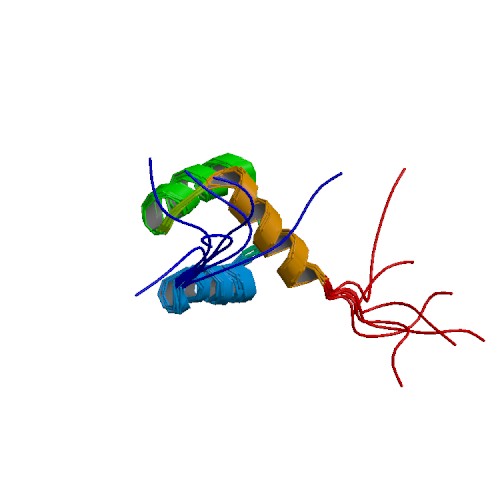HOXA5
| Homeobox A5 | |||||||||||||
|---|---|---|---|---|---|---|---|---|---|---|---|---|---|
 PDB rendering based on 1hom. | |||||||||||||
| |||||||||||||
| Identifiers | |||||||||||||
| Symbols | HOXA5 ; HOX1; HOX1.3; HOX1C; MGC9376 | ||||||||||||
| External IDs | Template:OMIM5 Template:MGI HomoloGene: 40726 | ||||||||||||
| |||||||||||||
| RNA expression pattern | |||||||||||||
 | |||||||||||||
| More reference expression data | |||||||||||||
| Orthologs | |||||||||||||
| Template:GNF Ortholog box | |||||||||||||
| Species | Human | Mouse | |||||||||||
| Entrez | n/a | n/a | |||||||||||
| Ensembl | n/a | n/a | |||||||||||
| UniProt | n/a | n/a | |||||||||||
| RefSeq (mRNA) | n/a | n/a | |||||||||||
| RefSeq (protein) | n/a | n/a | |||||||||||
| Location (UCSC) | n/a | n/a | |||||||||||
| PubMed search | n/a | n/a | |||||||||||
Homeobox A5, also known as HOXA5, is a human gene.[1]
In vertebrates, the genes encoding the class of transcription factors called homeobox genes are found in clusters named A, B, C, and D on four separate chromosomes. Expression of these proteins is spatially and temporally regulated during embryonic development. This gene is part of the A cluster on chromosome 7 and encodes a DNA-binding transcription factor which may regulate gene expression, morphogenesis, and differentiation. Methylation of this gene may result in the loss of its expression and, since the encoded protein upregulates the tumor suppressor p53, this protein may play an important role in tumorigenesis.[1]
See also
References
Further reading
- Scott MP (1992). "Vertebrate homeobox gene nomenclature". Cell. 71 (4): 551–3. PMID 1358459.
- McAlpine PJ, Shows TB (1990). "Nomenclature for human homeobox genes". Genomics. 7 (3): 460. PMID 1973146.
- Tournier-Lasserve E, Odenwald WF, Garbern J; et al. (1989). "Remarkable intron and exon sequence conservation in human and mouse homeobox Hox 1.3 genes". Mol. Cell. Biol. 9 (5): 2273–8. PMID 2568583.
- Boncinelli E, Acampora D, Pannese M; et al. (1990). "Organization of human class I homeobox genes". Genome. 31 (2): 745–56. PMID 2576652.
- Miano JM, Firulli AB, Olson EN; et al. (1996). "Restricted expression of homeobox genes distinguishes fetal from adult human smooth muscle cells". Proc. Natl. Acad. Sci. U.S.A. 93 (2): 900–5. PMID 8570656.
- Apiou F, Flagiello D, Cillo C; et al. (1996). "Fine mapping of human HOX gene clusters". Cytogenet. Cell Genet. 73 (1–2): 114–5. PMID 8646877.
- Lu Q, Kamps MP (1996). "Structural determinants within Pbx1 that mediate cooperative DNA binding with pentapeptide-containing Hox proteins: proposal for a model of a Pbx1-Hox-DNA complex". Mol. Cell. Biol. 16 (4): 1632–40. PMID 8657138.
- Stelnicki EJ, Kömüves LG, Kwong AO; et al. (1998). "HOX homeobox genes exhibit spatial and temporal changes in expression during human skin development". J. Invest. Dermatol. 110 (2): 110–5. doi:10.1046/j.1523-1747.1998.00092.x. PMID 9457903.
- Crooks GM, Fuller J, Petersen D; et al. (1999). "Constitutive HOXA5 expression inhibits erythropoiesis and increases myelopoiesis from human hematopoietic progenitors". Blood. 94 (2): 519–28. PMID 10397719.
- Dias Neto E, Correa RG, Verjovski-Almeida S; et al. (2000). "Shotgun sequencing of the human transcriptome with ORF expressed sequence tags". Proc. Natl. Acad. Sci. U.S.A. 97 (7): 3491–6. PMID 10737800.
- Raman V, Tamori A, Vali M; et al. (2000). "HOXA5 regulates expression of the progesterone receptor". J. Biol. Chem. 275 (34): 26551–5. doi:10.1074/jbc.C000324200. PMID 10875927.
- Raman V, Martensen SA, Reisman D; et al. (2000). "Compromised HOXA5 function can limit p53 expression in human breast tumours". Nature. 405 (6789): 974–8. doi:10.1038/35016125. PMID 10879542.
- Golpon HA, Geraci MW, Moore MD; et al. (2001). "HOX genes in human lung: altered expression in primary pulmonary hypertension and emphysema". Am. J. Pathol. 158 (3): 955–66. PMID 11238043.
- Kosaki K, Kosaki R, Suzuki T; et al. (2002). "Complete mutation analysis panel of the 39 human HOX genes". Teratology. 65 (2): 50–62. doi:10.1002/tera.10009. PMID 11857506.
- Foucher I, Volovitch M, Frain M; et al. (2002). "Hoxa5 overexpression correlates with IGFBP1 upregulation and postnatal dwarfism: evidence for an interaction between Hoxa5 and Forkhead box transcription factors". Development. 129 (17): 4065–74. PMID 12163409.
- Strausberg RL, Feingold EA, Grouse LH; et al. (2003). "Generation and initial analysis of more than 15,000 full-length human and mouse cDNA sequences". Proc. Natl. Acad. Sci. U.S.A. 99 (26): 16899–903. doi:10.1073/pnas.242603899. PMID 12477932.
- Foucher I, Montesinos ML, Volovitch M; et al. (2003). "Joint regulation of the MAP1B promoter by HNF3beta/Foxa2 and Engrailed is the result of a highly conserved mechanism for direct interaction of homeoproteins and Fox transcription factors". Development. 130 (9): 1867–76. PMID 12642491.
- Scherer SW, Cheung J, MacDonald JR; et al. (2003). "Human chromosome 7: DNA sequence and biology". Science. 300 (5620): 767–72. doi:10.1126/science.1083423. PMID 12690205.
- Hillier LW, Fulton RS, Fulton LA; et al. (2003). "The DNA sequence of human chromosome 7". Nature. 424 (6945): 157–64. doi:10.1038/nature01782. PMID 12853948.
- Chen H, Chung S, Sukumar S (2004). "HOXA5-induced apoptosis in breast cancer cells is mediated by caspases 2 and 8". Mol. Cell. Biol. 24 (2): 924–35. PMID 14701762.
External links
- HOXA5+protein,+human at the US National Library of Medicine Medical Subject Headings (MeSH)
This article incorporates text from the United States National Library of Medicine, which is in the public domain.
| This protein-related article is a stub. You can help Wikipedia by expanding it. |